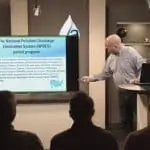

The purpose of the Quaternary Geology of Calumet and Manitowoc Counties, Wisconsin report is to provide an interpretation of the distribution and history of glacial deposits and a map showing their distribution.
This report should be useful for planning and development agencies in making land-use decisions, and to the non-metallic mining industry to aid in locating potential sources of aggregate.
The stratigraphic framework presented provides a basis for future detailed groundwater studies in the area. Finally, we hope that naturalists and others interested in the geologic history of the land on which we live will enjoy reading this report.
The report is available for sharing and downloading from the Wisconsin Geological & Natural History Survey.
We hope you find it both interesting and valuable. For geological surveys and information in other states, please contact us.
Stormwater Regulation is evolving, pushing more responsibility on to the dischargers by holding them accountable through categorization based on a discharger’s ability to meet numeric benchmarks. Additionally, how a discharger responds and applies effective BMPs determines their status. Ultimately, it is up to the industrial permittee to take the initiative, with an eye to priorities and feasibility for the future of their stormwater compliance program.
Stormwater managers and facility compliance personnel have only just begun to come to terms with the tiered ERA Response paradigm. However, as the tiered escalation becomes more common and ERA Level 1 and Level 2 reporting is performed, facilities are beginning to reach an equilibrium of stormwater compliance in terms of strategy, feasibility, budget and allocation of resources.

In his whitepaper, Jonathan Meronek, QISP, ToR, takes readers through the fundamental components of the ERA, Exceedance Response Action, or tiered Corrective Action compliance mechanism already in place, and currently being implemented in the States of California, Washington and the most recent General Permit in Oregon. ERA has wide-reaching implications for future NPDES permittees of industrial stormwater discharges. The escalation or “tiered” response standards is based on EPA Benchmark Levels and potential for future Numeric Effluent Limits (NELs). The three western states are viewed as “precursors” of what may be expected throughout the United States, as several key components of the forthcoming Multi-Sector General Permit (MSGP) will push other states to move towards similar ERA response scenarios and regulations.
SCS Engineers promotes Carlo Lebron to lead the Southeastern region operations, including all environmental consulting, landfill, landfill gas, and solid waste business. He commences his responsibilities immediately, under the title Business Unit Director, and is managing the staff and business operations of six offices in Florida and Georgia, and including projects in Puerto Rico. His primary office is located in Tampa, Florida.
Sustainable environmental programs require multi-disciplinary professionals who have highly technical engineering skills and can develop solutions in coordination with state and local entities, private businesses, and the public.
SCS Engineers announces several strategic management enhancements following its Board of Directors meeting in November. The firm promoted several individuals and hired new professionals to increase support for its landfill, waste management, and clean energy clients in states where recycling goals and the reduction of greenhouse gases are advancing at a rapid pace.
SCS Engineers is an employee-owned corporation, with a Board of Directors that sets policies, appoints officers and committees, and otherwise serves the employee-shareholders by governing the corporation. SCS Engineers includes three specialty business practices: SCS Field Services, SCS Energy, and SCS Tracer.

Promoted to Vice President were Myles Clewner (Florida), Jim Ritchie, Srividhya Viswanathan, Art Jones, and Sol Sim (California); and Tom Lock (Pennsylvania).
SCS also welcomes new Project Director, Daniel Dietch, to its Miami, Florida, office. Mr. Dietch comes to the firm with more than 20 years of academic and professional experience in solid waste management. His experience includes master planning, landfill closure plans, operations and technology reporting, rate models and cost-benefit analyses, data management, and procurement. His expertise will help support achieving state and local sustainable recycling and waste management goals. Mr. Dietch is also the Mayor of Surfside, Florida, and brings the unique big-picture perspective of a public servant.
“These colleagues are a key part of our success, and we are proud to announce their promotions,” said President and CEO Jim Walsh. “Our clients and SCS are thriving as new professionals join with our best and brightest employee-owners.”
The new Exceedance Response Action (ERA) paradigm has wide-reaching implications for future NPDES permittees of industrial stormwater discharges. This growing regulatory compliance mechanism is already being implemented in California, Washington, and most recently in Oregon. These states are viewed as precursors of future trends throughout the United States, as several key components of the forthcoming Multi-Sector General Permit (MSGP) will influence other states to move toward similar ERA response scenarios and regulations.
Join Forester University for this live, educational, two-part webinar as speaker Jonathan Meronek, QISP ToR, CPESC, QSDP/D, of SCS Engineers discusses the future of the tiered ERA paradigm and why stormwater managers and facility compliance personnel have only begun to come to terms with it. He will help you better understand if your site is covered and how an Industrial Permittee can come into compliance.
The webinar will examine past lessons, including the implementation of effective best management practices, water quality characterizations, and successful compliance strategies. It will also project what the compliance paradigm will look like during the first years of an industrial General NPDES Permit.
Attendees can expect to learn to:
Attendees can expect to earn credits: 2 PDH / 0.2 CEU
We will continue to see changes on the federal, state and local regulatory front that together will help us manage storm water in a smart, cost-effective manner preserving our water resources. Betsy Powers of SCS Engineers provides an update in her most recent article.
Until a new WOTUS definition is finalized, the U.S. EPA and the U.S. Department of the Army have indicated their intent to re-codify the pre-Obama regulations. The revised WOTUS rule is expected to include looser regulatory requirements, meaning fewer waters will qualify, and therefore, fewer permits will be required.
To speed up approvals of permits for highways, bridges, pipelines and other major infrastructure, an Obama-era executive order aimed at reducing exposure to flooding, sea level rise and other consequences of climate change were rolled back reducing the environmental reviews and restrictions on government-funded building projects in flood-prone areas.
Removing phosphorus from storm water runoff is a hot topic, with partners exploring alternative opportunities to reduce the introduction of phosphorus in runoff, remove it or manage it in watersheds.
More proprietary filters are being used for pretreatment before underground infiltration for redevelopment sites for total suspended solids (TSS) control and where land is limited. The performance of proprietary devices continues to be studied and improved to meet regulatory requirements. Increasing general attention is being paid to emerging contaminants that are problematic in storm water runoff. Among the emerging contaminants of concern are pharmaceutical and personal care products, pesticides, hydrocarbons, and hormones. Many of which are now included within the Endocrine Disrupting Chemicals group.

Betsy Powers is a civil and environmental engineer with SCS Engineers.
Of interest to industries concerned with wastewater ammonia treatment or landfill leachate ammonia treatment.
SCS Engineers publishes a new SCS Technical Bulletin entitled “Treatment of Ammonia in Wastewater and Leachate – Considerations and Technologies.”
Reducing the amount of ammonia in landfill leachate and other industrial wastewaters are often necessary to meet discharge standards. Proven wastewater treatment technologies can effectively reduce ammonia concentrations, but selecting the right technology requires careful consideration. This SCS Technical Bulletin provides background on ammonia in wastewater, and reviews factors to consider in selecting a treatment technology. The Bulletin includes a review of eight of the most common and effective treatment and disposal methods for wastewater with elevated ammonia or nitrogen.
Read or share the SCS Technical Bulletin here.
Explore SCS’s Liquids Management resources here.
Air rules are complicated. Landfill emissions differ from typical industrial sources resulting in rules that vary in significant ways. If you’re a landfill owner responsible for compliance, a regulator charged with monitoring landfills, or new to the industry, join us for this informative Air & Waste Management Association live presentation. The webinar will help you will learn how the rules affect landfills, understand what must be submitted and when, and the steps to take for compliance.
Ann O’Brien helps industrial and agricultural companies stay abreast of the regulatory information necessary to remain compliant with federal and state policies. Ann’s most recent series of articles for businesses in the printing or agricultural industries provides advice on air permits and the need for addressing the limits on visible emissions likely specified in their air permits.
Here’s what you need to know about what visible emissions are, how they’re regulated, and how to stay in compliance with your air permit. For other industries, please feel free to contact any SCS office or email us at service.scsengineers.com. We provide our professional services nationwide.


A federal appeals court ruled that the Obama administration’s rule to regulate coal ash does not go far enough in some areas. However, the court did not give environmentalists everything they were seeking. The U.S. Court of Appeals for the District of Columbia Circuit’s Aug. 21 decision in the case, Utility Solid Waste Activities Group v. EPA gave neither side all it wanted.
The decision comes as the Trump administration seeks to revise the EPA’s 2015 rule intended to regulate coal combustion residuals (CCR) from coal-fired power plants—one of the largest waste streams in the U.S. In July, the EPA issued a final rule granting more flexibility to industry and states. Both the Obama and Trump administrations have sought to give states the ability to create their own standards, but according to the D.C. Circuit, neither set of rules satisfied the Resource Conservation and Recovery Act–a 1976 law that allows the federal government to regulate solid waste generation, storage and disposal.
In its ruling, the court agreed that the EPA erred when it failed to mandate unlined CCR surface impoundments be closed, and when it exempted inactive impoundments from the regulation. The court also ruled that EPA should not have classified clay-lined impoundments as being lined.
The court also ruled against industry groups. For example, it determined that EPA does have the authority to regulate inactive impoundments and that it did provide enough public notice that it intended to apply aquifer-location criteria to existing impoundments.
The court also found that EPA decision to prohibit certain unencapsulated beneficial uses of CCR in amounts 12,400 tons or greater was arbitrary and remanded that decision to the EPA. The Agency had previously acknowledged the error in setting the 12,400 ton threshold (the threshold using the Agency’s methodology should have been about 75,000 tons).
Several industry publications have provided coverage of the decision and reaction from industry leaders, including E&E News, APPA, Utility Dive, Engineering News Record, and Courthouse News Service.
For questions or more information, please contact SCS Engineers’ staff.